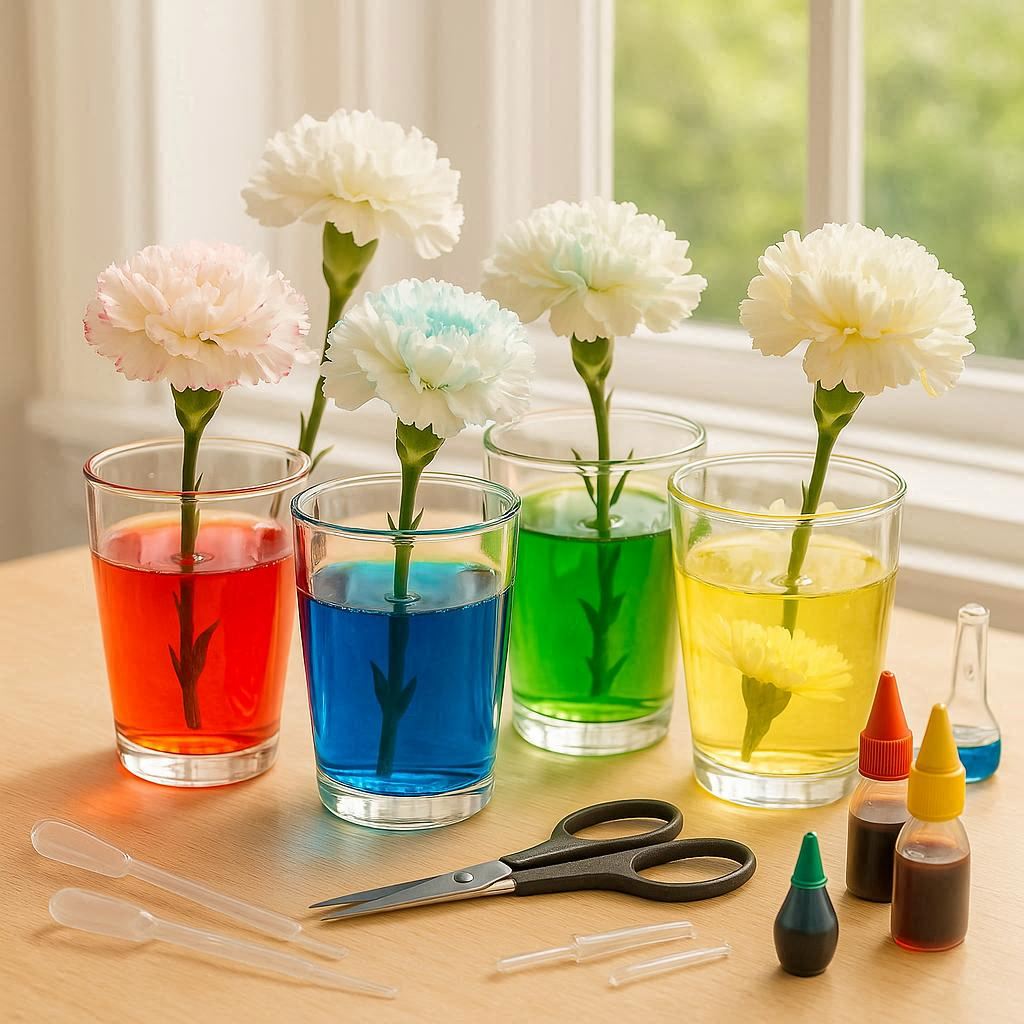Have you ever wondered what happens when you give your plants a drink of colorful water? This fascinating phenomenon, known as color shifting in plants, is not only a fun experiment but also a great way to teach kids and adults alike about the magic of nature and science. In this blog post, we’ll explore how you can make your flowers change colors and understand the science behind this incredible process.
Introduction
Plants have always been a source of fascination for humans. From their ability to photosynthesize to their incredible diversity in shapes, sizes, and colors, there’s no shortage of interesting facts about our green friends. One of the most intriguing aspects of plants is their ability to absorb water and nutrients through their roots and transport them to different parts of the plant. This process, called capillary action, is the key to making your flowers change colors.
In this article, we’ll guide you through a simple experiment where you can watch your plants drink colored water and change the color of their flowers. This experiment is perfect for classrooms, home educators, or anyone looking for a fun and educational activity to enjoy with their children.
How Does It Work?
Before we dive into the step-by-step guide, let’s take a moment to understand the science behind this phenomenon. Plants need water to survive, and they absorb it through their roots. The water is then transported to the rest of the plant through a system of tiny tubes called xylem. The xylem is responsible for carrying water and minerals from the roots to the leaves and other parts of the plant.
When you add food coloring to the water, the colored molecules are small enough to be absorbed by the roots and carried up the xylem. As the colored water reaches the petals of the flower, it gives them a temporary color change. This process usually takes a few hours to a few days, depending on the type of flower and the strength of the color.
A Step-by-Step Guide
Now that you understand the science behind it, let’s move on to the fun part – making your own color shifting flowers! Here’s what you need:
Materials Needed:
- White flowers: Carnations work best for this experiment, but you can also try roses, daisies, or any other white flower with thick, fleshy petals.
- Food coloring: Choose your favorite color or mix different colors to create unique shades.
- Water: Use room temperature water for the best results.
- A clean vase or container: Make sure it’s free from bacteria and other contaminants that could harm the flowers.
- A table spoon or stirrer: For mixing the colored water.
- Optional: A stopwatch or timer to track the progress.
Step 1: Prepare Your Flowers
Start by trimming the stems of your flowers at an angle using sharp scissors or pruning shears. This helps the flowers absorb water better. Remove any leaves that will be below the water level in the vase to prevent bacterial growth.
Step 2: Mix the Colored Water
Pour water into the vase, leaving enough space so that the stems won’t be fully submerged. Add a few drops of food coloring to the water and mix it well. For a more intense color, you can add a few more drops, but be careful not to make it too concentrated, as this could harm the flowers.
Step 3: Place the Flowers in the Colored Water
Gently place the flowers into the vase, making sure the stems are fully submerged in the colored water. If you’re using a timer, start it now to track how long it takes for the color to appear in the petals.
Step 4: Observe and Wait
Now comes the exciting part – waiting to see the color change! Depending on the type of flowers you’re using, you might start to see results within a few hours, but it could take up to a few days for the full effect. Keep the flowers in a bright, well-lit area to encourage maximum absorption.
Step 5: Enjoy Your Color Shifting Flowers
Once the color has reached the petals, you can enjoy your newly colored flowers. Remember that this color change is temporary and will fade over time as the flowers naturally shed their petals. To keep the color fresh, you can change the colored water every few days, but eventually, the flowers will return to their natural color.
The Science Behind Color Shifting Flowers
Now that you’ve successfully made your flowers change color, let’s dive deeper into the science behind this phenomenon. Understanding the process can help you appreciate the experiment even more and inspire you to try new variations.
Capillary Action
Capillary action is the key to this experiment. It’s the same force that allows plants to draw water from the soil and transport it to the rest of the plant. Capillary action occurs when the adhesion of water molecules to the inside of the xylem is greater than the cohesion between the water molecules themselves. This creates a sort of ‘capillary rise’ that pulls the water up the stem.
In this experiment, the colored water is pulled up the xylem as the flower absorbs it. As the colored water reaches the petals, it gives them a temporary color change. This process is completely safe for the flowers and won’t harm them as long as you use non-toxic food coloring.
Cellular Respiration and Photosynthesis
While capillary action is the primary mechanism behind the color change, it’s important to understand how it relates to the plant’s overall health. Plants use the water they absorb to carry out essential processes like cellular respiration and photosynthesis.
- Cellular Respiration: This is the process by which plants (and all living organisms) convert glucose into energy. Water plays a crucial role in this process, acting as a reactant and a product.
- Photosynthesis: This is the process by which plants convert light energy into chemical energy. Water is a key ingredient in photosynthesis, being split into oxygen and hydrogen during the light-dependent reactions.
By observing the color change in your flowers, you’re witnessing the plant’s ability to absorb and transport water, a fundamental process that sustains life on Earth.
Tips and Variations
Now that you’ve mastered the basics of color shifting flowers, here are some tips and variations to take your experiment to the next level:
1. Try Different Colors
One of the most fun aspects of this experiment is trying different colors. You can experiment with single colors, mix different shades to create unique hues, or even try layering colors to create a gradient effect. For example, you can add a few drops of blue and red food coloring to create a purple effect.
2. Use Natural Dyes
If you’re looking for a more natural approach, you can use natural dyes instead of food coloring. Beets, turmeric, and blueberries are all great options. Simply boil the natural dye in water until the color is vibrant, then let it cool before using it in your experiment.
3. Add a Few Drops of Oil
For a more dramatic effect, you can add a few drops of oil to the water. The oil will repel the water, creating a colorful, marbled effect in the petals. This works best with flowers that have thick, fleshy petals, like carnations or roses.
4. Use Different Types of Flowers
While carnations and roses are the most popular choices for this experiment, you can try other types of flowers to see how they react. Some flowers may absorb the color more quickly or intensely than others, depending on the thickness of their petals and the structure of their xylem.
5. Make It a Learning Experience
If you’re doing this experiment with kids, turn it into a learning experience by discussing the science behind it. Ask questions like, “Why do you think the color changes?” or “How do you think the plant absorbs the water?” to encourage critical thinking and curiosity.
FAQs
1. How Long Does It Take for the Color to Appear?
The time it takes for the color to appear depends on several factors, including the type of flower, the strength of the color, and the environmental conditions. With carnations, you might start to see results within a few hours, while other flowers may take a few days. Be patient and keep the flowers in a bright, well-lit area to encourage maximum absorption.
2. Does the Color Change Harm the Plant?
As long as you use non-toxic food coloring, the color change won’t harm the plant. However, if you’re using synthetic dyes or other chemicals, you should be cautious. Always prioritize the health and safety of the plant by using safe, non-toxic materials.
3. Can I Use Other Types of Flowers?
Absolutely! While carnations and roses are the most popular choices for this experiment, you can try other types of flowers to see how they react. Some flowers may absorb the color more quickly or intensely than others, depending on the thickness of their petals and the structure of their xylem.
4. How Long Does the Color Last?
The color change is temporary and will fade over time as the flowers naturally shed their petals. To keep the color fresh, you can change the colored water every few days, but eventually, the flowers will return to their natural color.
Conclusion
Color shifting flowers are a fun and educational way to explore the fascinating world of plants and capillary action. By following the steps outlined in this guide, you can create your own color shifting flowers and enjoy the magic of watching your plants drink colored water. Whether you’re a teacher looking for a classroom activity, a parent hoping to entertain your kids, or simply someone who loves plants, this experiment is sure to bring a smile to your face.
So next time you have a bouquet of white flowers, don’t be afraid to get creative and try this experiment. Who knows? You might just discover a new favorite hobby or inspire a future botanist!
If you enjoyed this article and want to learn more about the fascinating world of plants, be sure to check out our other articles on gardening tips, plant care, and DIY flower arrangements. Happy planting!



